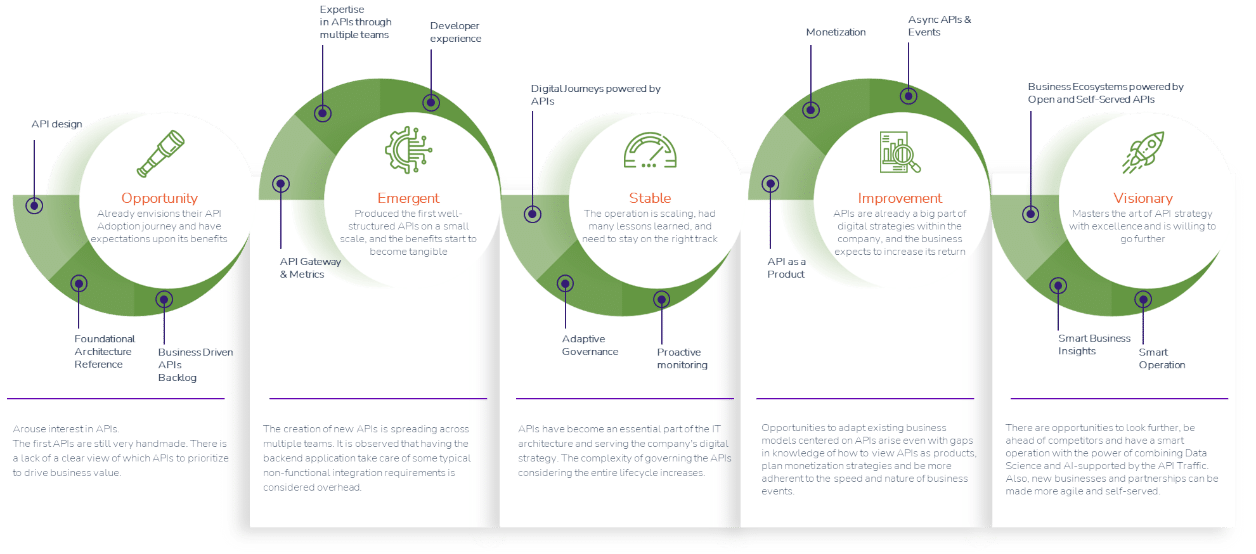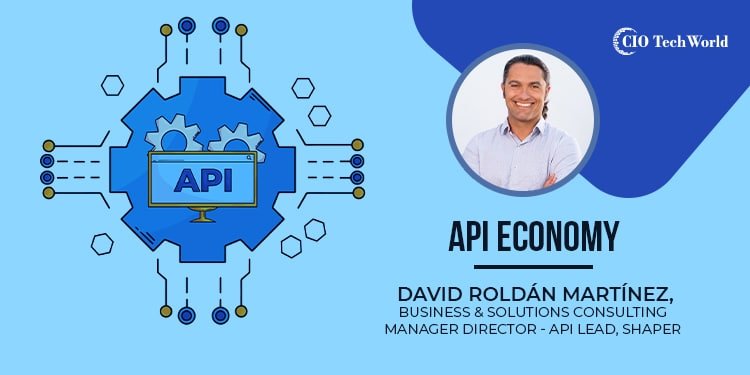In today’s rapidly evolving digital landscape, businesses are facing an unprecedented opportunity to transform the way they operate and innovate. The secret to this transformation lies in the API economy, a powerful force reshaping industries across the board.
It represents a remarkable journey towards business transformation and innovation. As a C-level leader, you have the unique opportunity to lead your organization into this promising frontier.
As your API Evangelist, I invite you to embark on a journey through this trailblazing domain, where we’ll explore the API economy’s immense potential and delve into strategies to lead your organization toward success.
The API Economy Unveiled
Imagine your organization as a hub of endless possibilities, where seamless integration, innovation, and expansion are not just goals but attainable realities. This is precisely what the API economy offers—a paradigm shift that empowers businesses to connect, collaborate, and capitalize on digital opportunities as never before.
The emergence of the API Economy has revolutionized the way companies scale, which is why those looking to elevate their business should consider how to harness its power.
APIs make critical connections between the systems powering our global economy and allow businesses to build new functions and experiences without having to start from scratch. In fact, APIs are becoming the digital reflection of an organization. Some of the benefits provided by APIs are well-known and include:
- APIs enable data to become more accessible, flexible, and accurate
- They empower digital transformation
- Businesses scaling
- Streamline operations and processes
- Deliver a more fine-tuned customer experience
- Additional revenue streams
APIs represent more than technical conduits for sharing data. This recent Forbes article on the crucial role APIs play in driving the global economy shows that, given the increasing importance of APIs, organizations need to focus on designing engaging API experiences for developers and organizational strategists and this only can be achieved by considering API as Products; and, in managing an API as a product to address elements of the entire API lifecycle
Being the CIO: the Trailblazer’s Role
As a CIO or C-level executive, you hold the reins of your organization’s technology strategy. Your role in embracing the API economy is pivotal, as it requires visionary leadership and a deep understanding of the transformative power of APIs.
Some of the challenges you’ll be facing are:
- Unlocking Innovation: In an era of rapid change, staying ahead of the curve means fostering innovation at every turn. APIs enable your business to unlock innovation not only from within but also from a diverse range of external developers. The API economy is an innovation accelerator, creating an ecosystem of ideas, where creative minds contribute to your growth.
- Monetizing Digital Assets: The API economy isn’t just about enabling innovation; it’s also a revenue-generating opportunity. By offering APIs to external partners, developers, and customers, you can monetize your digital assets. These assets may include data, services, or specialized functionalities, allowing you to diversify your income streams and explore new business models.
- Orchestrating Ecosystem Growth: Collaboration is the cornerstone of success in the API economy. Embracing this digital frontier allows you to expand your organization’s ecosystem, fostering partnerships and synergies with like-minded entities. Such collaborations magnify your reach and amplify your value proposition to customers.
Sectors of Transformation
The API economy has the potential to revolutionize a multitude of industries. Just for you to be aware of its potential impact, let’s have a closer look at how different sectors can harness the power of APIs:
- E-Commerce and Retail: In the e-commerce realm, APIs enable seamless integration of payment gateways, inventory management, and third-party logistics services. These integrations streamline the shopping experience and allow for personalized recommendations, driving customer loyalty and sales.
- Healthcare: APIs offer a lifeline for healthcare by facilitating interoperability between electronic health records, telemedicine platforms, and wearable devices. This integration enhances patient care, enables data-driven decision-making, and creates opportunities for healthcare startups to thrive.
- Finance and Fintech: The financial sector thrives on data and connectivity. APIs provide the infrastructure for real-time transactions, investment platforms, and financial analysis tools. Fintech startups leverage APIs to create disruptive solutions, enabling you to stay competitive and offer innovative financial services.
- Education: In the educational landscape, APIs connect learning management systems, student information systems, and online content providers. This interconnectedness allows for personalized learning experiences, data analytics for educators, and collaborative platforms that extend beyond traditional classroom boundaries.
- Transportation and Logistics: APIs are the driving force behind the logistics and transportation sectors, enabling route optimization, package tracking, and delivery coordination. Whether you’re in the shipping industry or managing a fleet of vehicles, APIs enhance efficiency and customer satisfaction.
- Energy and Utilities: Smart grids, IoT devices, and energy management systems rely on APIs for data exchange and control. The API economy allows energy companies to optimize resource usage, reduce costs, and create sustainable solutions.
Critical Steps for Successfully Embracing the API Economy
Trailblazing the API economy is not just a trend; it’s a transformative journey that can redefine the way your organization operates, collaborates, and innovates. As a CIO or C-level executive, your leadership in this domain is instrumental.
The API economy is dynamic and ever evolving. Regularly review your API strategy and adjust based on changing market conditions and feedback from users and developers. Encourage teams to innovate and experiment with new API offerings to stay competitive and relevant.
To trailblaze the API economy in your organization, consider the following strategies:
- Define Your API Strategy and Roadmap: Start with a clear API strategy that aligns with your business goals. Determine the value your APIs can offer to partners and customers. Are you enabling innovation, streamlining processes, or enhancing customer experiences?
- Security and Compliance: Prioritize security and compliance in your API ecosystem. Implement robust security measures to protect data and transactions. Ensure your APIs adhere to industry standards and regulations.
- Developer Experience: Provide a developer-friendly experience to attract and retain external developers. Offering comprehensive documentation, sandbox environments, and support resources will encourage collaboration and innovation.
- Customer Centricity: APIs are not just technical components; they are enablers of exceptional customer experiences.
- API Monetization: Explore different monetization models for your APIs. These may include pay-as-you-go pricing, subscription plans, or freemium options. The key is to find a pricing structure that aligns with your market and the value you provide.
- Ecosystem Building: Actively seek partnerships and collaborations with organizations that can amplify your offerings. Consider joining API marketplaces and developer communities to expand your ecosystem.
API Strategy and Roadmap
A successful API Economy roadmap helps a company’s transformation goals become a digital reality. It is a strategic plan that outlines the steps and milestones an organization needs to achieve in its journey toward the API Economy and it serves as a guiding document that helps an organization navigate the complexities of implementing digital technologies and evolving its processes and culture to become more digitally mature.
To develop a solid API strategy and roadmap, you’ll need to consider the following three key points:
- Clear Objectives: Define your organization’s specific objectives for APIs. Are you aiming to drive revenue, improve customer experiences, enhance operational efficiency, or all of the above? Your objectives should align with your overall business goals.
- Prioritize API Projects: Identify which APIs will have the most significant impact and prioritize them accordingly. Consider quick wins that can demonstrate the value of APIs to stakeholders.
- Scalability and Flexibility: Plan for the long term by designing an API architecture that can scale as your business grows. Ensure that your APIs can adapt to changing market conditions and customer needs.
A well-defined API Journey roadmap provides clarity, alignment, and a structured approach to executing the transformation journey. It helps ensure that everyone in your organization understands the goals and steps involved in becoming more digitally mature, which is essential for succeeding. Additionally, it enables your businesses to adapt to changing circumstances and technologies as you progress through your digital journey.
One of the main points of building an API Journey roadmap is assessing the API maturity level of the organization. This can be a complex and challenging process but it’s essential if you want to know where you are and where you want to be, which are the foundations of any roadmap (see Figure 1). Here are some of the top pain points that organizations may encounter when evaluating their API maturity:
- Lack of Standardization: Organizations may struggle with standardizing their API development and management practices, leading to inconsistency and inefficiency.
- Inadequate Documentation: Poor documentation can make it difficult for teams to understand and maintain APIs, leading to confusion and errors.
- Security Concerns: APIs can create potential security risks, and organizations need to ensure that their APIs are secure and meet regulatory compliance requirements.
- Interoperability Issues: APIs must be interoperable across different systems and technologies. Compatibility issues can cause delays and make it difficult to achieve the desired functionality.
- Performance and Scalability: APIs must be performant and scalable to meet the demands of different users and use cases. Performance issues can cause frustration for users and reduce the value of the API.
- Lack of Governance: Organizations need to have a clear API governance strategy in place to ensure that APIs are developed, managed, and used consistently across the organization.
- Legacy Systems: Organizations may struggle with integrating APIs into legacy systems, leading to compatibility issues and delays in development.
- Resource Constraints: Assessing API maturity can be resource-intensive, and organizations may struggle with allocating the necessary resources to the process.
- Limited User Adoption: APIs must be designed with user needs in mind, and organizations may struggle with getting users to adopt new APIs.
- Lack of Analytics: Organizations need to have a comprehensive analytics strategy in place to monitor API usage and performance and identify areas for improvement.

Note that the API economy is not a static landscape. It continues to evolve, and the pace of change is accelerating. To future-proof your API strategy, you’ll also need to consider API Standards evolution, compliance, and the integration with emerging technologies such as IoT, AI, or, Machine Learning.
Security and Compliance
Security and compliance are paramount in the API economy. As you expose your digital assets to external entities, protecting sensitive data and adhering to regulations are non-negotiable.
We delved into detail in a previous article, so let me highlight my main pieces of advice there:
- Prioritize API Security: Make API security a top-level priority in your organization’s digital strategy. Allocate the necessary resources and expertise to protect your API ecosystem.
- Invest in Training: Ensure that your teams, from developers to IT administrators, are well-versed in API security best practices. Knowledge is your best defense.
- Implement API Governance: Enforce documentation standards and security practices across the organization. This ensures consistency and reduces the risk of vulnerabilities.
- Stay Informed: The threat landscape is constantly evolving. Stay informed about emerging threats and adapt your security measures accordingly.
Developer Experience
Creating an enticing developer experience is essential to attracting external developers to your API ecosystem. Developers are the lifeblood of innovation in the API economy. Consider these aspects:
- Comprehensive Documentation: Provide detailed and up-to-date documentation that helps developers understand your APIs, use cases, and integration procedures.
- Developer Portal: Set up a developer portal where developers can access resources, obtain API keys, and test their integrations in a sandbox environment.
- Support and Communication: Offer developer support channels, such as forums or chat, to assist with inquiries and issues promptly. Maintain open lines of communication with your developer community to gather feedback and improve your APIs.
Customer-Centric API Design
In the API economy, customer-centricity is key to success. APIs are not just technical components; they are enablers of exceptional customer experiences. Here’s how you can ensure that your APIs are designed with the customer in mind:
- User-Centered APIs: Understand your customers’ needs and preferences. Design APIs that enhance their experience by providing valuable features, personalization, and seamless integration.
- Feedback Loops: Establish mechanisms for collecting feedback from API users and developers. Regularly assess user satisfaction, identify pain points, and iterate on your APIs based on this feedback.
- Data-Driven Insights: Leverage the data generated by your APIs to gain a deeper understanding of customer behaviors and preferences. Use this information to refine your offerings and tailor them to customer demands.
Monetization Strategies
Monetizing your APIs can be a significant source of revenue and a core element of your API economy strategy. Various pricing strategies can be employed for the purpose of revenue generation. Here are a few illustrative examples of API monetization models:
- Usage-Based Pricing: Under this scheme, each API call or data consumption is individually billed. This approach is most suitable for well-established digital product providers.
- Subscription Model: This involves a flat subscription fee to access one or a set of APIs. It’s ideal for APIs that offer valuable functionality without incurring unpredictable costs due to extensive data usage.
- Freemium Model: In the freemium model, developers can access a basic API for free up to a predefined limit. Beyond this threshold, they transition to a tiered pay-per-use pricing structure. This is a popular choice for public APIs, promoting widespread adoption, and offering more predictable scaling of operational expenses.
- Pay-Per-Transaction: Developers are charged for each transaction, which can encompass multiple APIs. Similar to pay-per-use, this strategy works well for established digital service providers.
- Revenue Sharing: The revenue generated from the API is shared between the provider and the developer. This arrangement is suitable when both parties benefit from each API usage. For instance, a travel website created by a developer might expose an API provided by a car rental agency, leading to a shared revenue model.
- Ad-Free Content: In this model, the API is initially supported by advertising revenue, but users can remove ads by making a payment. This approach is commonly observed in high-volume, low-cost applications.
- Paid Partner Program: Here, partners integrate your content to attract potential traffic, earning compensation based on user engagement, clicks, impressions, or even purchases. This strategy assists online retailers in refining their customer targeting efforts.
Building an API monetization strategy isn’t always easy or apparent, though. To help you get started with API monetization or further refine your process, Nordic APIs have put together some tips for API monetization to help you transform your APIs into a profitable product:
- Charge for API Access
- Provide Services Through Your APIs
- Drive Traffic To Your Site
- Create an API For A Non-API Site or Service
- API Exposure Through Business Partners
- Create Actionable Goals and Metrics
- Think Of It As A New Product Launch
Ecosystem Building and Partnerships
Digital ecosystems enabled by APIs are reshaping the business landscape, offering opportunities for innovation and growth. By understanding the different ecosystem types and implementing these tips, organizations can create, nurture, and consolidate successful digital ecosystems that drive value and competitiveness in today’s digital world.
Digital ecosystems come in various forms, each tailored to specific purposes and industries. They can be categorized into several types, including:
- Platform Ecosystems: These are built around a central platform or service, such as social media platforms (e.g., Facebook, Twitter) or cloud computing platforms (e.g., Amazon Web Services, Microsoft Azure). APIs enable third-party developers to create applications that enhance the core platform’s functionality.
- Industry Ecosystems: These ecosystems cater to specific industries, like healthcare, finance, or e-commerce. APIs enable various stakeholders within the industry to share data, services, and insights for mutual benefit.
- IoT (Internet of Things) Ecosystems: In the IoT realm, APIs facilitate seamless communication between a wide range of connected devices, enabling the creation of smart homes, smart cities, and industrial automation solutions.
- Open Banking Ecosystems: These ecosystems, often mandated by regulations, allow banks and financial institutions to securely share customer data and financial services with authorized third-party providers through APIs.
- Developer Ecosystems: Companies like Apple and Google have established robust developer ecosystems around their operating systems and app stores. Third-party developers use APIs to create apps that run on these platforms.
Quantifying the success of your API initiatives is essential for ongoing improvement and decision-making. Establish KPIs and metrics to measure the impact of your API strategy, such as:
- API Usage: Monitor the number of API calls, the adoption rate, and the growth of your API user base.
- Revenue Generation: Track the revenue generated through API monetization, including subscription fees and pay-as-you-go charges.
- Customer Satisfaction: Collect feedback and conduct surveys to assess the satisfaction levels of API users and developers.
- Innovation Index: Measure the rate of new API-based products or services created within your organization and the external developer community.
- Operational Efficiency: Analyze how APIs have improved operational processes, reduced costs, and increased overall efficiency.
On the other side, effective governance is essential to maintaining order and quality within your API ecosystem. Establishing a comprehensive API governance framework ensures that your APIs adhere to best practices and meet organizational standards. Key elements of API governance include:
- API Design Standards: Define design standards and best practices that all APIs within your organization should follow. This includes naming conventions, data formats, and error-handling guidelines.
- Versioning and Deprecation: Implement a clear versioning strategy to manage API changes. Communicate version updates and deprecations effectively to minimize disruption for users.
- Access Control and Security: Enforce access control policies and security measures consistently across all APIs. This includes managing user access, authentication, and data protection.
- Compliance and Regulation: Stay updated on industry regulations and compliance requirements that impact your API operations. Ensure that your APIs meet legal and security standards to protect user data and maintain trust.
I recommend reading this previous article about API Governance.
API Economy Success Stories
To inspire and guide your journey in the API economy, it’s valuable to explore success stories from organizations that have reaped the benefits. These case studies can offer insights and best practices for your own API initiatives.
- Netflix: Netflix is a prime example of a company that has leveraged APIs to enhance its user experience. Its API allows third-party developers to create applications and integrations that provide additional value to Netflix users.
- Salesforce: Salesforce’s extensive API ecosystem has been integral to its growth. It enables organizations to extend and customize their Salesforce implementations, creating a vibrant ecosystem of apps and integrations.
- Stripe: Stripe has built a successful payment processing platform, largely using APIs. Its developer-friendly approach and feature-rich APIs have made it a top choice for e-commerce businesses.
Conclusion: Pioneering the Future
As a trailblazer in the API economy, you can shape not only your organization’s future but also the future of your industry. It is a dynamic and transformative landscape that rewards innovation, collaboration, and a commitment to customer-centricity.
The journey may be challenging, but it’s also one filled with boundless opportunities for growth, revenue, and impact. By taking the reins and embracing the API economy, you’re not just leading your organization into the future; you’re pioneering it.
So, are you prepared to be at the forefront of this digital revolution, charting a course into uncharted territories of possibility? The choice is yours, and the future awaits.

Expert in APIs, AI, Digital Transformation, Business Solutions, and Open Economy related sectors. I bring a unique blend of technical and business expertise to the table. With a proven track record of delivering successful solutions for businesses of all sizes, I have helped organizations develop innovative business solutions by understanding their pain points and challenges and designing a roadmap to overcome them and drive growth.
My extensive experience in APIs at all levels has enabled me to work on a variety of complex projects, from building custom integrations to managing complex API ecosystems. I have a deep understanding of the intricacies of the API landscape.









